The previous post on drill core orientation looked at different methods and potential problems. This post looks at some more core orientation issues and procedures that will alleviate most of them.
Frequency of core orientation marks
The frequency of orientation marks will usually be every 6m if the drill rig is completing 6m core runs. If the drill-rig is completing 3m core runs and very accurate structural data is required, orientation marks could be taken every 3m. The onus is on the geologist to check the frequency of the marks and to check the quality of every one of them. This is not an onerous task and there is no excuse for not doing it. A change to greater intervals between orientation marks should only occur in instances of very good ground and proven consistency of the orientations. However, we would recommend against that.
I worked on a job at a major gold deposit in Ghana where the core recovery and integrity was great. Unfortunately, a short time in the core yard revealed numerous problems with the orientation process. The drillers were being paid to produce oriented core but, due to lack of diligence by the geologists, they were being a bit naughty. In some cases there were intervals of up to 60m between orientation marks. As such, there was no easy way to check the integrity of the marks in detail. If we wanted three marks to line up we would have to check 120m of core. Furthermore, the company was not getting the product (the orientation mark) they were paying for. This is inexcusable and was a product of geologists not monitoring the process. I spoke to the Canadian drilling foreman and he was a good bloke and we resolved the issue. However, this should not have been my job and I suspect the geologist ‘in charge’ didn’t want to leave his air conditioned office.
Implementation of orientation method
Successful dialogue needs to occur between the driller and the geologist to establish whether or not the drillers are confident in the application of the chosen method. For example, if the Reflex™ tool method is introduced then a Reflex™ tool representative should cover every shift with all drillers and the drilling foreman until everyone is familiar with the method.
The geologist managing the project needs to become familiar with the orientation method at the start of the drilling program. Drillers can be a wealth of knowledge and time spent at the rig is never wasted. At the very least, the geologist may pick up errors by the driller, which will mean early elimination of bad orientation marks.
Geologists and drillers should both be comfortable that the method being used is working well. In some cases it will be necessary to do a comparison of methods to see if similar methods are achieved e.g. using both the Ezy-Mark and a spear.
Ongoing surveillance of the orientation process
A simple problem that commonly occurs when using instruments such as the Reflex™
tool is that the driller transfers the orientation mark incorrectly from the face of the core to the outside of the core or vice-versa. Both marks need to be checked in the coreyard during the next marking up phase.
For the spear method the geologist should always check the correct shape and tolerances of spears, especially those that have been manufactured ‘on-the-spot’. The geologist should hear alarm bells when the driller says ‘no worries, we’ll just whip up a spear and use that’. I have seen some remarkably bad spears that have been ‘whipped up’ and in all cases the orientations were unusable.
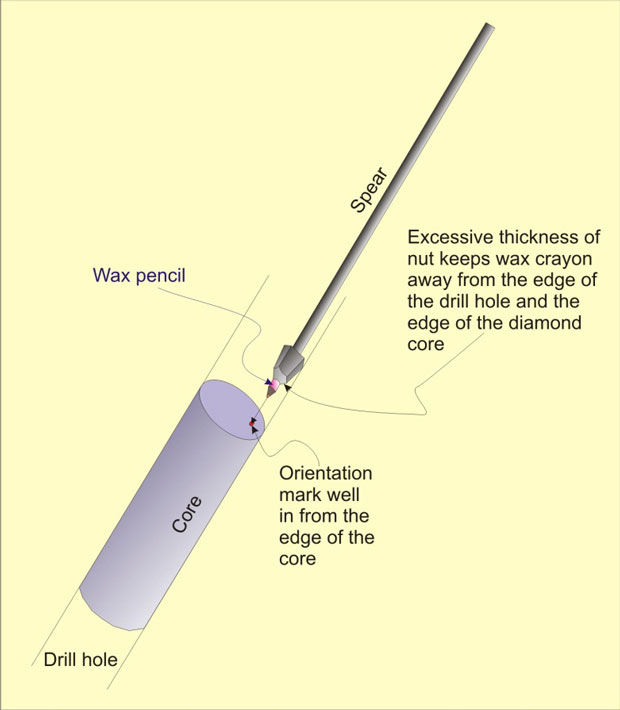
Example of a spear manufactured by a drilling crew in Serbia. The huge nut at the end of the spear was attached to hold the wax crayon. Unfortunately, the diameter of the nut meant that the crayon would never mark near the core edge.
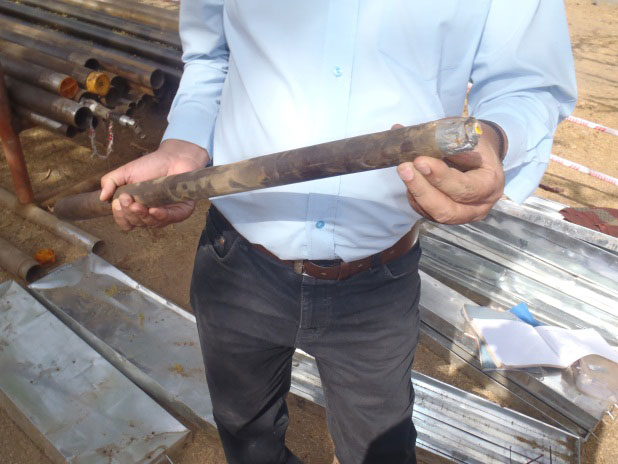
Example of a spear used on a job in India. There is no taper on the spear and the crayon was loosely held by gaffer tape.
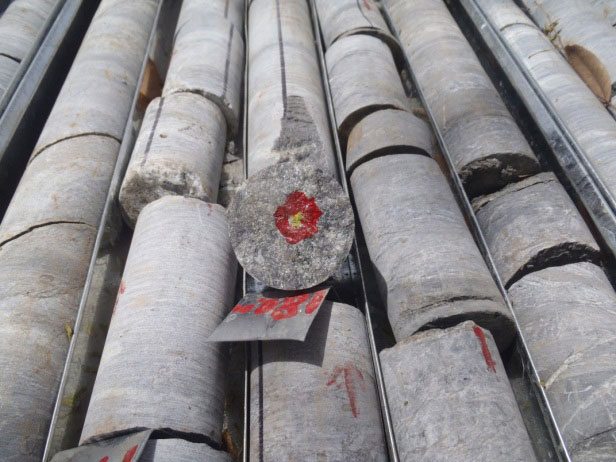
This produced marks like the one shown above. Note that the orientation mark is the yellow spot but the mark has been vandalised by a drillers trying to be helpful through painting around the mark. Both the state of the spear and the mark should have been identified by the geologist in charge and rectified.
Keeping track of the culprits
This raises another point. Never tell the drillers you are going to visit the rig to inspect the orientation process and equipment. If you do that it can give them time to cover up things that they don’t want you to see, and which you really do not want to see. For example, I was working on a job where a spear was being used for orientations and there was no consistency in the marks. I asked the drillers if the spear was bent and they emphatically told me it wasn't. On hearing this I stupidly told them I would go up to the rig that day to check the equipment. When I got there everything was in order and there was no apparent explanation for the bad orientations – the spear I was shown was fine, the rock was competent with few breaks, the hole plunged at a moderate angle (-60 degrees). It was only as I was about to walk away that I glanced over the side of the drill pad and saw something hidden in the bushes. You guessed it – it was the bent spear that the drillers had been using, which had hastily been hidden and replaced with a new one because they knew I was going to visit.
To allow a bit of detective work, and to deter unscrupulous behaviour, the driller responsible for the orientation mark on the core should put his initials on the block at the same core break. Although the driller should be able to be identified from the drill plods, their initials on the block make the task easier and they make the driller aware of his responsibility in the core orientation process. In other words, the driller will tend to use a bit more caution if he knows he can be identified.
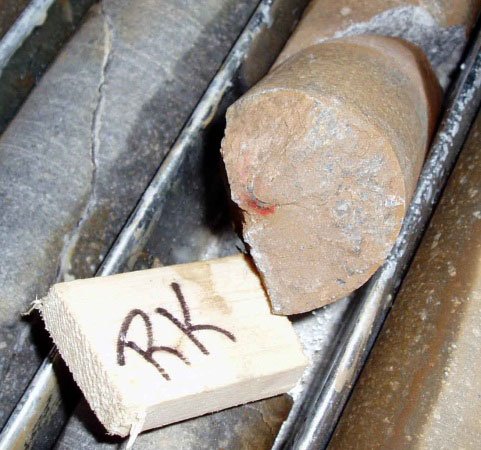
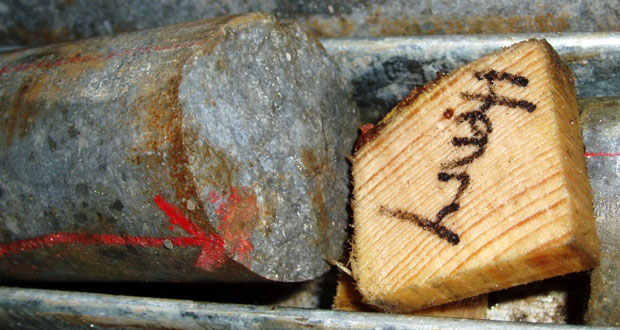
Examples of driller identification on core blocks at the break where the orientation was taken. RK has produced an unusable mark whereas Henry has produced a good mark.
The identification of drillers and their corresponding marks can circumvent a couple of problems. It is rare, but sometimes drillers will fabricate the marks. It may be that the driller gets paid for each orientation in the program, which can lead to drillers putting a mark with no integrity on the core if the orientation process/tool has failed to work. This can happen especially on night shift when it is a bit hard to see if a mark has been made or not by the tool. If you see marks like the one in the figure below then get suspicious because it is just a little bit too perfect. The alarm bells should ring if there are a series of perfect marks!
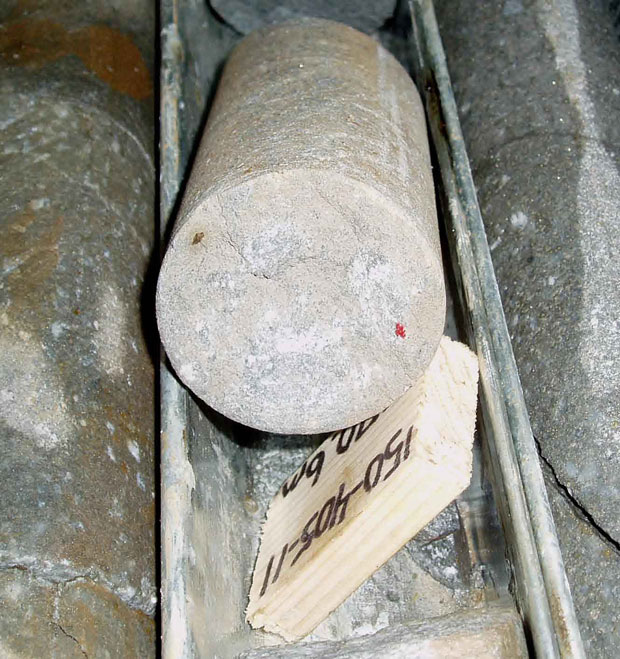
Example of a very discrete orientation mark near the edge of the core. This mark was allegedly made by a spear. If so, the guy who did this was one of the best drillers in the world. This mark has been fabricated.
The other thing that identification of the drillers serves to do is finding out who is competent enough to use the orientation method. If one driller consistently produces bad marks, or no marks at all, then consider moving him to another role not involving orienting the core. I remember an underground diamond driller I had at Mt Isa who we had to move him to other duties. If the core wasn’t badly broken it was inevitably in the core box around the wrong way. I forget the number of times he was made to come down to the core shed to reassemble the core correctly. He wasn’t being a problem for the sake of it – he just wasn’t capable of performing the duties in that role (I suspect there was a component of dyslexia involved).
Some final comments
It is imperative that the core be marked up and the confidence of the orientation lines be examined while the drilling program is underway. If the mark-up process in the core yard lags too far behind the drilling and orientation process this can mean that several holes (or more) may get drilled before errors are found.
As a final comment, sometimes the sophisticated methods such as the Reflex™ tool just don’t seem to work. I have seen occasions where both the geologists and the the Reflex™ tool representatives could not resolve why the instrument was giving variable orientations across shifts and using different drillers. This has been in cases in the Arctic, where the problem could perhaps be attributed to the effects of cold on the instrument, through to cases where good drilling conditions were present and the problem was perhaps attributable to the instrument. The instrument is rated to -30°C and conditions in the Arctic were commonly colder than this.
In such cases, where more than one instrument in each of the non-spear methods is being used on the same hole, the blocks need to be marked with the instrument number. Also, a number of continuous orientations need to be taken with each instrument in order to check the repeatability of the measurements.
Ultimately, the onus is on the drillers and the geologists to monitor the orientation process and results in order to ensure quality orientation marks. Essential to this is a good rapport and and two-way respect between the drillers and the geologists.
Get the full PowerPoint (converted to PDF) if you are registered with Orefind.com